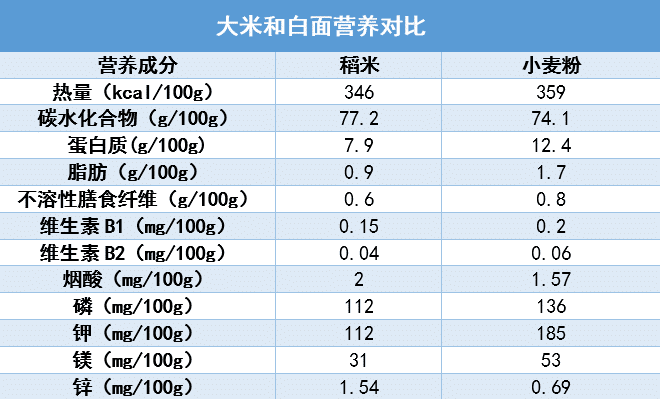Who is more nutritious, rice or noodles?Check out 4 Tips for Food Staples

[ad_1]
On the dining table of Chinese residents, rice and noodles have a very high status and are irreplaceable staple foods. In daily life, some people prefer to eat rice, and some people like to eat noodles. Some families even argue endlessly over whether to eat rice or noodles for today’s meal. Why are there such dietary differences? Which one is more worth eating, rice or noodles, and how to eat it healthily? Let’s let Mi Hemian compete against each other to see who is more “powerful”.
Which is easier to gain weight, rice or noodles?
Let me tell you the answer first: eating noodles is easy to gain weight.
Staple food is the bulk of energy intake in the daily diet, so for people who are controlling their weight, they will pay special attention to which one is easier to gain weight by eating rice or noodles. So which one is easier to eat to gain weight? There are really relevant studies in this area. Considering the types of food that can be made from rice and noodles, eating noodles is relatively easier to gain weight.
First of all, there are too many delicacies that can be made from pasta, such as oil cakes, fried dough sticks, buns, dumplings, pies, pot stickers, bread, shortbread, etc. These delicacies are not only delicious, but also high in oil and sugar. In terms of calories, most pasta has higher calories than rice. For example, the calories of Hanamaki, steamed buns, and oil cakes are nearly 1.8 times, 2 times, and 3.5 times that of steamed rice, respectively. If you eat every meal and don’t control your intake, it’s hard not to get fat. In addition, current studies have shown that replacing wheat with the same frequency and amount of rice can reduce the risk of excessive body fat. A recent study from the School of Public Health, Xi’an Jiaotong University School of Medicine included more than 100,000 people to observe the relationship between their staple food preference and obesity. The results showed that compared with those who love pasta, people who love rice Lower belly fat.
If you really like to eat pasta, but want to reduce calorie intake and control your weight, it is recommended that in addition to giving priority to pasta containing whole grains, you should also eat pasta with less oil and sugar. In addition, the amount should be controlled. The general population can eat 1 to 1.5 fistfuls of staple food per meal.
Who is more nutritious, rice or noodles?
Let me tell you the answer first: the nutrition is about the same.
The main task of rice and noodles is to provide carbohydrates and calories, and the two are comparable in this regard. In terms of protein content, flour is higher than rice, but the protein quality of both is not as good as that of meat, egg and milk, which is easier to be absorbed and utilized by the human body.
In terms of dietary fiber content, the insoluble dietary fiber of wheat is originally 18 times that of rice, but after being processed into wheat flour, it will be greatly lost, leaving only 0.8 g/100 g, which is similar to the content of rice. As for the content of other vitamins, minerals and other nutrients, there is not much difference between the two.
Drawing: Xue Qingxin
So on the whole, there is no need to worry about who is more nutritious, rice or white flour. If you are very concerned about the nutrition of the staple food, it is recommended to match the thickness and increase the intake of whole grains. For example, people who love to eat rice can replace 1/3 of the rice with miscellaneous grains and beans. In addition, it is very good to make oatmeal rice, black rice, barley rice, quinoa rice, brown rice, black bean rice, red bean rice, etc. Those who love to eat pasta can use miscellaneous grain noodles instead of some wheat flour to make buckwheat steamed buns, corn flour steamed buns, oatmeal steamed buns, sorghum noodles, buckwheat noodles, etc.
Who is more likely to raise blood sugar between rice and noodles?
Let me tell you the answer first: comparable.
In terms of raising blood sugar, it depends on the GI value. The higher the GI value, the greater the postprandial blood sugar response after eating. Both polished rice and white flour are high GI foods. The GI of rice is as high as 82, and the GI of white steamed bread is 85. The carbohydrate content of the two is similar, so the ability to raise blood sugar is comparable, and eating as a staple food is not conducive to blood sugar control. In addition, many people like to eat rice porridge. The longer the porridge is cooked, the higher the GI value and the greater the blood sugar response after meals.
Although diabetics need to control blood sugar, they cannot stop eating staple foods in order to control blood sugar. It is recommended to do the following 4 points:
1. Match thickness
Don’t eat too finely, and increase your intake of whole grains. For example, the GI value can be reduced from 85 to 67 if white flour steamed buns are replaced with buckwheat steamed buns; another example is to replace rice with whole grain oatmeal rice, and the GI value can be reduced from 82 to 42.
In addition, if it is porridge, it is best to put some miscellaneous beans. Studies have shown that the blood sugar response of bean and rice porridge is significantly lower than that of japonica rice porridge, but the satiety index is significantly higher than that of japonica rice porridge. Such changes are not only very effective in controlling blood sugar, but also help to control food intake. Of course, you can also grind mixed beans into flour and mix them into flour to make steamed buns with mixed beans, which will also improve the taste.
2. Don’t overcook the food
When cooking rice, the greater the rice-to-water ratio, the longer the soaking time, and the greater the cooking pressure, etc., will all lead to an increase in the GI value of the rice. When cooking porridge, the longer the cooking time, the worse the porridge will be, the easier it is to digest and absorb, and the GI value will be higher.
3. Pay attention to diet
A meal should include not only staple foods, but also vegetables and protein foods. A mixed meal is more conducive to controlling postprandial blood sugar. For example, steamed buns + scrambled eggs with celery (low GI), pancakes + fried fungus with eggs (low GI), fried pork with rice + celery (medium GI), rice + scrambled eggs with garlic sprouts (medium GI), and pork buns with celery (low GI).
4. Pay attention to the order of eating
You can eat vegetables and protein food first, then eat the main food, and drink soup last; or drink soup first, then eat vegetables and protein food, and eat the main food last. The soup should be light, with less oil and less salt, and it is best not to contain starch to thicken.
This article was reviewed by Zhang Na, associate researcher and doctoral supervisor of Peking University School of Public Health.
[ad_2]
Source link

![[Love Wants Sexual Happiness Series 358]Find the culprit and overcome psychogenic erectile dysfunction. Don’t let pressure affect your sexual happiness.](https://chinathenews.com/wp-content/uploads/2024/04/171111-780x420.jpg)

![[Wanqingyi Care]My health, my rights, customized medical methods in the last stage of life](https://chinathenews.com/wp-content/uploads/2024/04/ZZ1-100-780x420.jpg)
![[Kidney Transplantation Special Topic]The survival rate of transplanted kidneys is high without dialysis treatment three times a week](https://chinathenews.com/wp-content/uploads/2024/04/1311-780x420.jpg)



